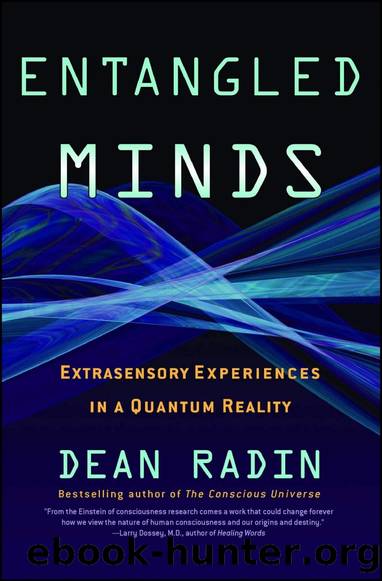Entangled Minds: Extrasensory Experiences in a Quantum Reality by Dean Radin

Author:Dean Radin [Radin, Dean]
Language: eng
Format: epub
ISBN: 9781416516774
Barnesnoble:
Goodreads: 216543
Published: 0101-01-01T00:00:00+00:00
CHAPTER 13
THEORiES OF PSi
Albert Einstein, reporting a conversation with an unnamed but âimportant theoretical physicist,â regarding telepathy:1
He: I am inclined to believe in telepathy.
Einstein: This has probably more to do with physics than with psychology.
He: Yes.
Psi phenomena present three key problems for theory development. The first is that information has to reach across space and time in ways that defy common sense. As Einstein said, this is a problem for physics. The second is that this information must arrive in your mind without the use of the ordinary senses, and it must be able to interact with objects at a distance. This is a problem for both physics and the neurosciences. And the third is that information must reach conscious awareness often enough for people to report it. This is a problem for psychology and the neurosciences.
Physics is first on the list because all three problems are closely related to our conception of physical reality. If the physical medium in which we live prohibits information from flowing in the required ways, then the only rational conclusion is that reports of psi must be due to error. From that perspective, ESP must mean âError Some Place,â despite what any experimental evidence might suggest.
Fortunately, knowledge about the nature of physical reality has evolved over the past few millennia, as we discussed in the last chapter. The direction of that evolution suggests that the âerror hypothesisâ is becoming less likely and the psi hypothesis more likely. To help ground this discussion, itâs useful to see how concepts about the relationships among matter, mind and psi have evolved.
There are four periods in this evolution corresponding to ancient, classical, modern, and possible future eras (Figure 13-1). In ancient times the principal concept of reality was anima mundi, the living universe. This âAge of Magicâ
lasted for tens of thousands of years, and the metaphor of the timesâthe zeitgeistâwas spirit. Reality was imagined to exist in cycles. This was inferred from the rhythms observed in the stars, the seasons, the days, and the lifecycles of all living creatures. It was taken for granted that the nature of reality rested upon the whims of the gods, and it was assumed that animate spirits could
cause things to happen at a distance without mediation, at least without known cause within âourâ world. The concept of mind was associated with the soul, a spark of divine presence within us. Psi phenomena in the ancient era were considered self-evident, as a natural form of communion between soul and spirits.
The next step was the classical scientific era. In classical times the overriding concept of reality was as a mechanical universe. This âAge of Industryâ lasted from about the seventeenth century to the mid-twentieth century, and the zeitgeist was a clockwork. Basic physical concepts like time, space, energy, and matter were imagined to be fixed, absolute, and fundamentally different substances. It was taken for granted that reality existed in an absolute sense, independent of observers, and it was an additional token of faith that action at a distance was impossible.
Download
This site does not store any files on its server. We only index and link to content provided by other sites. Please contact the content providers to delete copyright contents if any and email us, we'll remove relevant links or contents immediately.
| ESP | Near-Death Experiences |
| Out-of-Body Experiences |
Animal Frequency by Melissa Alvarez(3762)
Sigil Witchery by Laura Tempest Zakroff(3657)
Real Magic by Dean Radin PhD(3575)
Fingerprints of the Gods by Graham Hancock(3224)
The Rosicrucians by Christopher McIntosh(3058)
Aleister Crowley: The Biography by Tobias Churton(3026)
Journeys Out of the Body by Robert Monroe(2998)
Alchemy and Alchemists by C. J. S. Thompson(2917)
Mysteries by Colin Wilson(2891)
Hitler's Monsters by Eric Kurlander(2737)
John Dee and the Empire of Angels by Jason Louv(2717)
Wicca: a guide for the solitary practitioner by Scott Cunningham(2711)
The Hatha Yoga Pradipika (Translated) by Svatmarama(2498)
Infinite Energy Technologies by Finley Eversole(2495)
Dark Star Rising by Gary Lachman(2426)
The Book of Lies by Aleister Crowley(2388)
Aliens by Jim Al-Khalili(2387)
To Light a Sacred Flame by Silver RavenWolf(2357)
Hitler's Flying Saucers: A Guide to German Flying Discs of the Second World War by Stevens Henry(2301)
